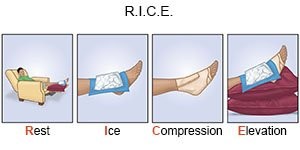4 Common Foot and Ankle Injuries

There are 26 bones, 33 joints, and over 100 tendons, muscles and ligaments in each foot that work together to support your weight and enable you to move around. Foot and ankle injuries are common and they can be caused by a serious accident, work, sports or something that occurs in daily life. If you’re dealing with the symptoms of a foot or ankle issue, you should make an appointment with a qualified orthopaedic Foot and Ankle specialist to receive a proper diagnosis and develop an effective treatment plan.

Five Common Foot and Ankle Injuries
1. Ankle Sprains
Ankle sprains are among the most common injuries we see when the foot twists, rolls, or turns beyond its range of motion causing one or more ligaments to be overstretched or torn resulting in pain, swelling, and sometimes an inability to bear weight.
You may experience pain and stiffness a few days after injury, but it will often heal on its own with rest within two to four weeks for minor sprains. Icing your ankle can help reduce swelling as well. However, high ankle sprains, which affect the ligaments just above the ankle, are more severe. These types of injuries may require advanced sprain treatments, like a brace or boot to keep the ankle straight while it heals which may take anywhere from six to twelve weeks to heal a severe sprain
2. Achilles Tendonitis & Achilles Rupture
The Achilles tendon is the largest tendon in the body connecting the two primary calf muscles to the bone in the heel. Achilles Tendonitis (or Tears) is when you overwork this tendon causing inflammation and swelling which can be painful due to small tears in the fibres of the middle portion of your tendon. It usually occurs when you do not warm up before a workout or sports and straining the calf muscles from repeated or intense movements. Achilles Rupture is a more severe injury from Tendonitis where the tendon connecting to the heel is completely severed. You may hear a snapping or popping noise when it happens followed by a sharp, sudden pain in the back of the ankle near the heel. While there are many home remedies to treat Tendonitis, a Rupture would most likely require surgery to reattach the severed tendon to the heel.
3. Plantar Fasciitis
Plantar fasciitis is a common condition felt when people get up from bed and feel a stabbing pain in their heels when they take their first few steps. This condition occurs due to the inflammation of the plantar fascia which is a tendon located under the foot, stretching across the arch. It’s a thick band of tissue that extends from the inner edge of the heel to the toes. The discomfort typically happens when the area is aggravated. This injury is mostly experienced by high-impact sports, extra weight, and jobs that require walking or standing on hard surfaces for extensive periods. However, it can happen to anyone.
4. Stress Fractures
Stress Fractures are excessive and repetitive force that causes microscopic cracks in the bones. For athletes, it usually occurs on the foot and lower leg from intense workouts or activities such as basketball, dancing, or running and the supporting muscles do not have enough time to heal, transferring the stress to the bones which could potentially severe pain. The most common sites for stress fractures in the foot are the metatarsal bones, heel bone, navicular, talus, and sesamoids. The most common symptom of a stress fracture is pain and swelling on the top of the foot or on the outside of the ankle. You would need to have an x-ray or bone scan to diagnose the severity of the fracture.
RICE method
R.I.C.E. stands for rest, ice, compression, and elevation and it is a simple self-care and home remedy technique that helps reduce swelling, ease pain, and speed up healing for minor foot and ankle injuries.
- Rest - Stop all activities that would put pressure or weight on the injury and rest for 1 to 2 days. until you can walk without pain. If the pain persists, see a doctor and you might be advised to use assistive devices or mobility aids (such as a cane or a sling) that may help reduce pressure on an injured joint or limb.
- Ice - Apply a cold gel pack or bag of ice wrapped in a towel to the injured area to minimize swelling and pain. Icing is believed to be most effective when applied for 20 minutes on and off for 2-3 hours after the injury has occurred until the swelling starts to reduce.
- Compression - Another way to reduce the swelling is to compress the injury with an elastic medical bandage, or wear a special pneumatic boot that would help with blood circulation. If you experience pain, numbness, cold or tingling feeling, it could mean the wrapping is too tight and has to be slightly loosened.
- Elevation - Use pillows to raise the injured foot or ankle above your heart level so it does not collect fluids around the injured area. Doing this would prevent additional swelling and pain.

Conducting the RICE method as soon as possible after an injury is crucial to begin the healing process. The purpose of the RICE method is to prevent the injury from becoming worse from excessive swelling. It can cause a lot of pain and movement restrictions due to soreness and inflammation around the injury and it slows down blood flow and nutrients leading to tissue damage and other complications.
If the RICE method does not improve the injury within 2 days, see a doctor as soon as possible for an examination and a treatment plan so that no further damage would be caused to the injury.
Where to buy high quality medical equipment and supplies?
Visit our online store at www.neolee.com.my
Customer enquiries:
Phone: (KL) 03-92129402 / (JB) 07-5190350
Email: general.enquiry@neolee.com.my
or Visit our showroom
For more stories like this, join our Facebook community on Facebook
Need help with your order? chat with us here via Whatsapp
Nov 17,2022
